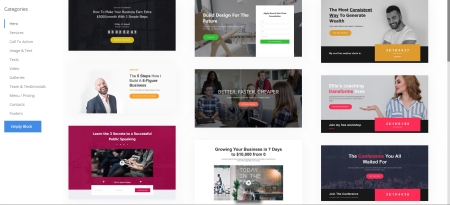 There are a lot of template-driven website providers out there, each promising you the ability to build a website quickly, easily, and with little to no web design experience. Our earlier reviews have focused on older, more established providers, but today we’re going to take a look at a newer face that’s been making waves in the industry – Simvoly.
There are a lot of template-driven website providers out there, each promising you the ability to build a website quickly, easily, and with little to no web design experience. Our earlier reviews have focused on older, more established providers, but today we’re going to take a look at a newer face that’s been making waves in the industry – Simvoly.
Founded in 2016, Simvoly’s web design platform was created by two Bulgarian engineers who spent two years developing their environment, and have spent the last three polishing it for use with e-commerce and as a solution for companies that wish to brand the platform under their own name (referred to as White Label).
As a company that also started with the efforts of two developers in 2016, we know the time and effort that goes into delivering top-quality work, so we couldn’t wait to put their platform to the test and see how their efforts delivered compared to not just WordPress but also the other, larger out of the box providers out there.
Like our other platform reviews, we’ll be using our standard criteria for evaluation, established in our earlier post discussing the benefits of free website design vs premium website design. If you don’t remember what they are, don’t worry, we’ve got your refresher right here:
- How much actual control do you get over your website?
- Do you get access to your settings and hosting, or are you at the mercy of Simvoly’s own hosting setup?
- Do you own some of the content, all of the content, or none of the content?
- Is the design SEO-friendly?
- Is the platform compatible with 3rd party coding?
Each category gets a full review of pros and cons, and is measured with a rating between 0 and 10. Any score of 0 showcases an unforgivable flaw that should keep you far away from the platform, while a score of 10 means that it is as beneficial as WordPress, the platform we use for all our website design services.
Afterward, we’ll review particularly unique points to keep in mind that do not fit well within these categories, and then factor them in with the average of the other 5 ratings for our final score.
To ensure fair grading, we started with a free trial at simvoly.com, and will be discussing our experience as new users working with their website design tools. All lasting plans are paid plans, so bear that in mind if you intend to use their service. Read on to see what we discovered!
Jump ahead to:
What level of control do you have over your website at Simvoly? Rating – 8/10

These blocks can be further enhanced by a variety of widgets. If you’ve worked with the Gutenberg editor in WordPress, this designer will feel very similar.
During my revisit in May of 2019, I found that Simvoly added templates for funnels in addition to the options to create a regular website, a store, or a landing page. For those who are unfamiliar, funnels are primarily designed to have all your visitors take a specific action when they visit your website, such as signing up for an email list, booking an appointment, or buying a specific product. This is an excellent addition to an already good selection of options for addressing different needs.
Naturally, this also means Simvoly has also expanded their website template selection. We’re up to 57 regular website templates, around 20 of which seem to carry over to the online store option.
Landing pages and funnels present additional choices beyond these templates if you need something simpler for your web presence. While you might (correctly) note that many other providers boast more choices, that doesn’t really matter if the presented templates have the right features under the hood. Time to put Simvoly’s editor through its paces!
After spending some time with their tutorial video, we know we’re working with another block interface like Weebly or Duda. If you’d rather wait to watch it, Simvoly also emails a link to it and other more specialized videos as soon as you get started, so you’ll never have to dig for a guide. This seems like a small thing, but it’s a huge quality of life improvement we were really impressed by.
Despite its appearance as a typical block interface with widgets, we also found Simvoly offers significantly more design flexibility and greater ease of use than its competitors without sacrificing the rigidity these platforms are known for. Dragging elements to different places and resizing them feels natural; you can adjust the size of the blocks by placing them in a specific spot in the column or by dragging at the corners/sides, and you can toggle how many columns a section has to place greater or lesser emphasis on certain points.
Column toggling can be a bit treacherous, however. Simvoly has a tendency to make all columns default to the same size when switching back and forth, creating severe issues with blocks that contain pre-built spacers. It also tries to condense content when reducing columns, but does not put it back when expanding again. Fortunately, you can just remove and re-add a block broken in this manner, but having to do so is a little annoying.
|
|
|
Beyond this, the learning curve is generally not punishing – especially with the attention to detail in the video tutorials. Save often, discard changes if you break something you don’t know how to fix, and you’ll find yourself making great progress in no time.
Designing even felt easy enough to be on par with Squarespace in some regards, but the more we played around in Simvoly’s system, the more we noticed the two companies excel in different areas. Squarespace gives you a lot of different types of blocks to create with that are extremely well designed, but inflexible. Simvoly gives you a more generic selection of blocks that are less polished, but you hold greater control over how they can be configured.
Unfortunately, this same level of flexibility does not seem to extend to their tablet and mobile views. Though you can choose to hide page elements that don’t look good on a phone, every part of your mobile website is going to take its cues from the desktop version. In a world where mobile traffic represents a majority, this is less than ideal, and is a definite step back compared to mobile specialists like Duda.
Your storefront options are very nicely organized, and offer flexible options for product listings, managing discounts, orders, currency, and shipping. There are a few options we’d like to see in the future (such as the ability to set up bulk product discounts), but with features like membership group configuration and a lack of transaction fees from Simvoly, this is still a good setup many stores will be able to take advantage of. You can also connect your store to a whole host of payment providers, including popular options like PayPal, Stripe, and Authorize.Net.
Last, but certainly not least, the blog setup is well designed and modeled after the elements that make WordPress’s blogs the envy of the Internet. Categories, tags, sidebars, headers, and a variety of post setups that draw upon the same design system as the rest of your website make creating, navigating, and managing your posts a breeze.
Overall, this is an excellent way to manage a WYSIWYG block interface. For a brief overview on navigating Simvoly’s website editor, you should check out the video below.
What level of access do you have to Simvoly’s hosting platform? Rating – 1/10
No FTP or SSH access is available here. While this is a standard for template-driven platforms, the unfortunate side effect is that should you need more control over your hosting settings, desire the ability to save a backup on your computer, or need to change hosts, you simply cannot without starting over.
Worse still, there’s no real internal backup system in your Simvoly dashboard either. The best option available to you is the ability to clone your site, which while better than nothing, is a poor substitute for a feature that should be considered standard issue.
Put simply, the mediocrity in this category hasn’t improved since the initial review, which is a real shame. Web companies won’t want to touch Simvoly unless they’re making money on the White Label program (more on that later), and regular users have basically nothing to protect them if they save an edit they change their mind about down the road or if something happens to their content on Simvoly’s servers.
This is especially gross because section 2.1 of Simvoly’s Terms of Service puts all responsibility for website content on the users. You know without any reasonable way for them to back up their content (and no, copy-pasting text to a Word document, archiving images, and other piecemeal methods that would result in your site being redesigned in the event of a Simvoly failure do not count as reasonable).
What percentage of my content do I own? Rating – 3/10 (users), 0/10 (White Label)
Since you probably still have them tabbed from earlier, we’re going to direct you to section 2.2 of Simvoly’s Terms of Service to start.

No, no, no. Unacceptable. While section 2.2 indicates you as the owner of your content, the next sentence nullifies it immediately after by granting Simvoly a royalty-free, non-exclusive, interchangeable, unalterable right to your content to provide you with their services.
Basically, they can use your work for free to develop their platform or do anything else they like so long as they deem it necessary for providing you their services. Simvoly can also use your content for any marketing or promotional purposes according to section 2.3, unless you opt out by emailing them.
A reworked version of that clause is also present in section 12.4 of the White Label Terms of Service too. Seems kind of hypocritical when they start getting defensive about their own intellectual property in section 5 of the same agreement. Then again, their main Terms of Service specified a waiving of claims involving moral rights in section 2.3, so I think it’s pretty clear where their priorities lie at this point.
In summary, as was found during our Squarespace review, Simvoly is a WYSIWYG company trying to have their cake and eat it too when it comes to the intellectual property rights they can exercise. We encourage you to act with extreme caution if you should choose to set up shop with them as a user.
If you’re considering a partnership with Simvoly’s White Label program, we advise that you steer clear. While the verbiage pointed out in section 12.4 about data management earlier isn’t -quite- as egregious as Duda’s, it’s definitely in the same neighborhood, making it a deal breaker.
Is Simvoly’s environment SEO friendly? Rating – 9/10
A lot of good things are bundled together here, including SSL protection, flexible page URLs, meta titles/descriptions, alt tags, responsive design, and header tags. Nothing is hidden behind an array of crazy menus, so getting a solid SEO foundation is going to be natural and straightforward during the design process. If you get stuck, Simvoly even has a video to help you cover some basics!
Coding is also pretty clean, so you won’t have to worry about any bulk holding up your load times. I noticed virtually no lag when loading pages I had created as well, which speaks well of the servers Simvoly uses to host your content.
Unfortunately, URL redirection is not available, so once you choose your URL layout, be prepared to stick with it for the long haul. This will be a fairly minor drawback for most people who plan to “set and forget” their website, but as your online needs evolve, this could prove to be a sticking point down the road.
One other interesting option of note is the ability to use an alternate header for some pages. This basically allows you to set up the top of a specific page (or pages) differently from the rest of the others on your website – a benefit many providers do not offer. You’ll probably get the most use out of this feature with membership portals, password protected pages, or showcasing different wings of your business in unique ways.
Finally, while you start with a free URL, paid annual plans receive the first year of a new domain registration for free. You also retain the ability to use URLs you have registered with a third-party registrar. If you elect to use the free URL, reduce this score to 8/10 as not having your own is a strike against your SEO.
How compatible is Simvoly with 3rd party code? Rating – 8/10
While there was some definite ambiguity with the code widget that Simvoly provides you, steps have been taken to clear that up since our initial review. It is now easy to see that you can add global website code using HTML, CSS, and Javascript in your Website Settings, and the coding help video Simvoly has created specifies you can use HTML and scripting with the aforementioned widget in specific places on a page as well.
Naturally, this means you or your developer can add standard features like Google Analytics to your website with relatively little trouble, as well as custom functions you need to address most specific needs.
It is a little surprising not to have a specific place laid out for the former, as WYSIWYGs typically strive to meet the needs of those with relatively little web knowledge, but this is certainly not a deal breaker.
Your widget library also offers the ability to add contact forms, social media buttons, audio players, Google maps, and embed from popular environments like Youtube or Vimeo. This can be a big deal for showcasing products, adding flavor to blog posts, connecting created content, and providing extra visual aid where it is needed.
Additional applications can be found in your Dashboard Settings, but these currently deal with mass email marketing and Facebook Pixel. Not bad things to have by any means, but fairly limited when you consider that options for setting up industry-specific needs like restaurant reservations or MLS listings simply aren’t present. A savvy coder can probably help cover for this, but if GoCentral and Squarespace can make this easy, there’s no reason Simvoly can’t.
Your Dashboard Settings are also where you’ll find quick access to your data for website members, on-site analytics, payment connection, and a host of other site-wide settings. A number of your account settings are mixed in here as well, which threw me off a little bit while I was playing around in the builder. It takes away from the immersive experience to do this, proving to be more of a distraction than a convenience.
All in all, the average user and developer should still be very pleased with what is here, so I’m perfectly fine with bumping this score up from 7/10 to 8/10.
What are Simvoly’s unique pros and cons? Rating adjustment – -0.8 points
A year has brought a host of changes to this section, and while Simvoly has definitely started moving in the right direction, they’ve managed to create some new concerns while neglecting some of my earlier ones.
We’ll go ahead and start with documentation. Simvoly’s video guides are simply excellent, showcasing how to get from point A to point B in a way few other companies have achieved. Finding them’s also pretty easy – if you miss the email they send you after signing up, you can just click “Learn” at the top of their website, and they’ll be right there, ready for you to watch.
So why am I still finding their Help page on Google?
How is it that this is still a live page on your website? It provides no useful information in any category, giving the idea that support was a priority at one point, and is now nothing but an afterthought. Your videos clearly demonstrate this isn’t the case, but if this is a user’s first experience with you, it’s going to turn them away! Take it down or fill in the blanks – this is an embarrassing mistake for you to be making at this point in your business.

Speaking of careless errors, let’s direct our attention to the parts of the site Simvoly expects you to see now. Why are there spelling and grammar errors on your pages? I understand English may not be a primary language given your background, but you should at least hire an editor who speaks and writes it fluently!
The Changelog where Simvoly outlined updates they’ve made is also gone now, and has been replaced with a “Feature Requests” option at the bottom of their website. While nicely organized so you can see which requests are open, in progress, and completed, it isn’t quite the same. Definitely better than nothing though, and certainly still a step above most of their competition.
A more welcome change is the removal of their false advertising. Gone are the claims you’ll rank before anyone else on Google and that there won’t be transaction fees with third party providers, and all we can say is good riddance. Making guarantees on behalf of third parties that you can’t back up is just dishonest, and an extreme disservice to those who will take you at your word out of ignorance.
We also saw Simvoly offers the option to have one of their experts build you a site now as well. Pricing appears to be reasonable at $249 for a 3 page website and $399 for a 6 page site, with custom options available if you need more pages. While not a substitute for a professionally designed site using WordPress, I’ve certainly seen worse budget options for those who need to put something online but lack the time to do so.
Unfortunately, you’ll still have to deal with Simvoly’s extremely mediocre support options. Live chat and email are nice, but there’s no guaranteed response time for the meager contact form that is offered, and there is zero phone support for when you need help in the moment. If your target market is small and medium sized businesses, that’s just not acceptable.

Finally, let’s talk about your White Label program. The foundation you have set up for it is very likable. You can create templates for your clients to use with the Simvoly builder, commission management is well organized, and everyone wins financially if your customers build networks of clients for you with it. I just have one small request for you involving it:
Stay. Out. Of. My. Data. Stay out of my clients’ data too while you’re at it.
Don’t sell it to your partners. Don’t lay any kind of claim to it. I know your current terms say you can’t use it in such a way as to reveal who the data involves, but if you also give yourselves the right to advertise specific people as using the platform, it won’t be difficult for big data companies to put two and two together in a lot of cases. Until you fix this, I cannot recommend anyone use your White Label services for any reason.
Overall Rating – 5/10, stay away from the White Label program
There’s definite potential within what Simvoly has to offer, and they’ve made good strides in the last year. They still have some work to do to clear up the glaring issues that are holding them back.
Searching for a better web design alternative? Give us a call at 319-229-5225 or email design@midwestwebsites.com, and we’ll be happy to find a time to discuss your business website needs and help you establish the type of website you need to thrive!

Braden is one of the founders of Midwest Websites, and has been professionally writing and developing websites for over 7 years. His blog posts often take an experience from his life and showcase lessons from it to help you maximize online presence for your business.



